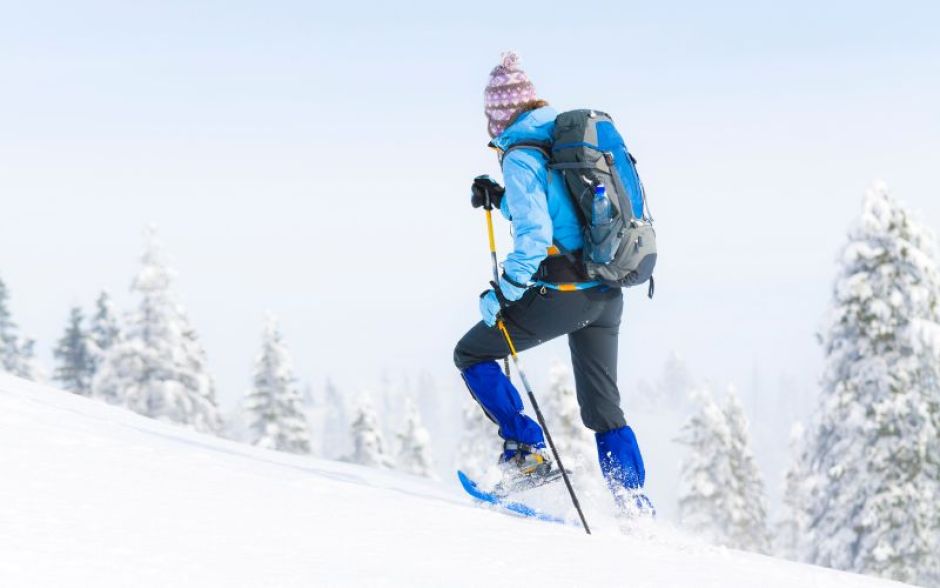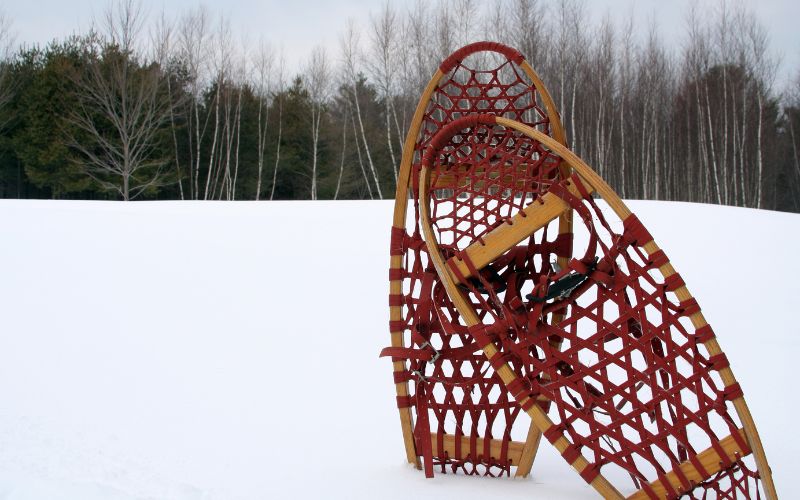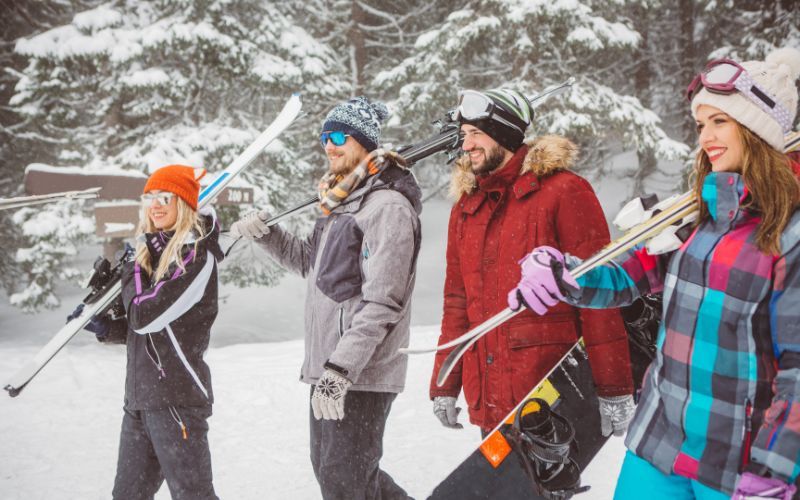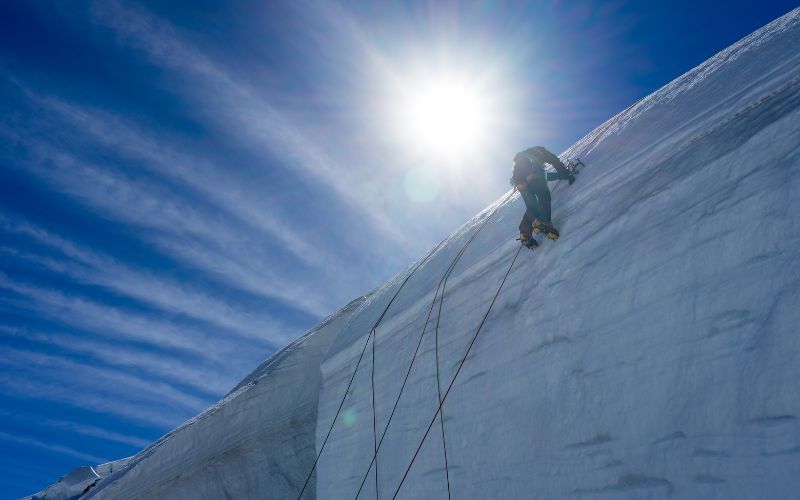
Snowshoeing: The Ultimate Winter Cardio Super Exercise 2023
Snowshoeing – In the frosty embrace of winter, when the world is blanketed in glistening snow, many outdoor enthusiasts seek thrilling ways to stay active and embrace the beauty of the season. Snowshoeing emerges as an exhilarating and accessible option that not only connects us with the pristine winter landscapes but also offers an incredible cardiovascular workout. This article delves deep into the world of snowshoeing, exploring its physical benefits, techniques, equipment, safety measures, and the sheer joy it brings to those who venture out into the winter wonderland.

Table of Contents
The Cardiovascular Marvel of Snowshoeing
Snowshoeing: A Heart-Pumping Adventure
Snowshoeing, often underestimated, is a hidden gem among winter activities. It’s an age-old practice that allows you to traverse snowy terrains with ease, making winter exploration more accessible. Beyond its convenience, snowshoeing is a remarkable cardiovascular exercise that elevates your heart rate and helps you burn calories effectively.
Elevating Your Heart Rate
One of the primary reasons why snowshoeing stands out as a cardiovascular marvel is its ability to get your heart pumping vigorously. As you trudge through deep snow or navigate hilly terrain, your heart rate increases significantly. This sustained elevation in heart rate is essential for improving cardiovascular fitness.
In fact, snowshoeing can be just as effective as traditional cardiovascular exercises like running or cycling. The combination of aerobic effort and the added resistance of snow makes it an ideal winter workout. This means that you can maintain or even improve your cardiovascular endurance, even when the ground is covered in snow and ice.

Burning Calories in the Snow
For those who are mindful of their calorie expenditure, snowshoeing is a fantastic calorie-burning activity. On average, a person can burn around 400-600 calories per hour while snowshoeing, depending on factors like terrain, speed, and body weight. This makes it an excellent choice for individuals looking to shed those extra winter pounds while enjoying the great outdoors.
Lower Impact on Joints
Unlike high-impact activities like running, snowshoeing is gentler on your joints. The snow cushions your steps, reducing the stress on your knees and hips. This makes it an excellent option for individuals with joint issues or those recovering from injuries who want to stay active during the winter months.
Stress Reduction in Nature
Apart from the physical benefits, snowshoeing offers mental wellness advantages. The tranquility of winter landscapes, the sound of snow crunching beneath your feet, and the crisp, clean air can have a calming effect on your mind. It provides an opportunity to disconnect from the hustle and bustle of daily life and immerse yourself in the serenity of nature.
In summary, snowshoeing isn’t just about conquering winter terrain; it’s a fantastic way to elevate your heart rate, burn calories, and boost your cardiovascular fitness. Whether you’re a fitness enthusiast, nature lover, or someone seeking a low-impact workout, snowshoeing has something to offer. It’s a winter adventure that combines the best of both physical and mental well-being, making it a truly heart-pumping experience.
Engaging Muscles for an Ultimate Workout
When you strap on a pair of snowshoes and venture into the winter wonderland, you’re not just treating your cardiovascular system to a workout; you’re engaging various muscle groups, creating the ultimate full-body experience.

Quadriceps: Powering Your Ascent
As you take each step forward in your snowshoes, your quadriceps, the muscles on the front of your thighs, come into play. These muscles work hard to lift your snowshoes with each stride, propelling you forward and upward on snowy hills. Snowshoeing uphill is an exceptional way to target and strengthen your quadriceps.
Hamstrings: The Force Behind Each Push
The muscles on the back of your thighs, known as the hamstrings, are engaged when you push your foot backward to create forward momentum. They play a crucial role in maintaining balance and controlling your stride, especially on varied terrain. Snowshoeing effectively conditions your hamstrings, contributing to improved leg strength and endurance.
Glutes: Stabilizing Your Hips
Your gluteal muscles, or buttocks, provide vital stability and power during uphill climbs. They help you maintain an upright posture and prevent your hips from swaying side to side. Strengthening your glutes through snowshoeing not only enhances your performance but also supports overall hip health.
Calves: Navigating Steep Slopes
Steep slopes require additional effort, and your calf muscles rise to the challenge. Snowshoeing demands strong calf muscles, especially when ascending or descending inclines. These muscles provide the necessary push-off power and help control your foot placement on uneven terrain.

Core: Balancing Act
Maintaining balance on snowy, uneven terrain is essential for a safe and enjoyable snowshoeing experience. Your core muscles, including your abdominal and lower back muscles, play a crucial role in stabilizing your torso and preventing falls. Engaging your core while snowshoeing not only improves balance but also adds a dimension of core strength training to your winter workout.
Shoulders and Arms: Propelling Forward
While snowshoeing, particularly when tackling more challenging terrain, the use of trekking poles comes into play. Coordinating your pole placements with your steps engages your shoulders and arms. This upper body involvement provides additional stability and helps propel you forward, especially when navigating through deep snow or climbing steep hills.
In summary, snowshoeing is more than just a cardio workout; it’s a holistic fitness experience that engages multiple muscle groups. From your quadriceps to your shoulders, it challenges and strengthens your entire body. Whether you’re looking to tone your legs, improve your balance, or get a full-body workout in the winter wonderland, snowshoeing delivers the ultimate muscle-engaging adventure.
Snowshoeing Equipment
Selecting the Right Snowshoes
The heart of any snowshoeing adventure lies in choosing the right pair of snowshoes. Your snowshoes are your companions on this snowy journey, and they can significantly impact your comfort and performance on the trails.

Size Matters: Finding the Perfect Fit
Snowshoes come in various sizes, each designed to accommodate different weights and types of terrain. It’s crucial to select the right size to ensure an enjoyable and safe experience. Consider the following factors:
- Body Weight: Heavier individuals will need larger snowshoes to distribute their weight and prevent sinking in deep snow.
- Terrain: For packed or groomed trails, smaller snowshoes are sufficient. However, if you plan to venture into deep powder or steep slopes, larger snowshoes with more floatation are necessary.
- Snow Conditions: Wet, heavy snow requires larger snowshoes than light, fluffy powder.
Binding Comfort and Security
Bindings are the interface between your boots and the snowshoes, so their comfort and security are paramount. Look for bindings that are easy to use and provide a secure fit. Some bindings are designed to accommodate a variety of boot sizes, making them versatile for different users.
Frame Material: Aluminum or Composite
Snowshoe frames are typically made of aluminum or composite materials. Aluminum frames are lightweight and durable, making them ideal for backcountry adventures. Composite frames, on the other hand, are more budget-friendly and suitable for casual snowshoers. Consider your intended use and budget when deciding on the frame material.
Heel Lifts: A Valuable Addition
Some snowshoes come with heel lifts, also known as climbing bars. These nifty additions can be flipped up to relieve calf strain when ascending steep slopes. If you plan on tackling hills, particularly on longer excursions, consider snowshoes with this feature for added comfort.
Traction: Teeth and Cleats
Snowshoes feature various traction elements on the underside, such as teeth and cleats. These provide grip on icy or hard-packed snow. For challenging terrain, look for snowshoes with aggressive traction systems to ensure stability and safety.
Women’s and Kids’ Specific Models
Manufacturers often offer snowshoes specifically designed for women and children. These models may have narrower frames and bindings tailored to different body sizes and shapes. If you’re purchasing snowshoes for family outings, consider these specialized options for a better fit.
In conclusion, selecting the right snowshoes is a critical step in ensuring a successful and enjoyable snowshoeing experience. Pay close attention to factors like size, bindings, frame material, traction, and additional features like heel lifts. With the right pair of snowshoes, you’ll be equipped to conquer winter trails with confidence and comfort, making the most of this ultimate winter cardio exercise.
The Importance of Poles
When it comes to snowshoeing, the right equipment can make all the difference in your experience. While snowshoes are the stars of the show, the importance of poles should not be underestimated. Snowshoeing poles, also known as trekking poles, are invaluable companions that enhance your stability, endurance, and overall enjoyment on the snowy trails.
Stability and Balance
Snowshoeing poles provide an additional point of contact with the snow, increasing your stability on uneven terrain. This extra support becomes especially crucial when navigating through deep snow, crossing icy patches, or traversing slopes. With poles in hand, you’ll find it easier to maintain your balance, reducing the risk of slips and falls.
Reducing Strain
Your arms and upper body play a significant role in snowshoeing, especially when tackling challenging terrain. Poles help distribute the workload between your upper and lower body, which can reduce strain on your legs and knees. This even distribution of effort can make long snowshoeing excursions more comfortable and less taxing on your muscles.
Uphill Assistance
When ascending steep slopes, snowshoeing poles become your best allies. Most poles come with adjustable lengths, allowing you to shorten them for uphill climbs. This adjustment eases the strain on your arms and shoulders while providing extra stability. Some poles even have handy features like heel lifts, which further assist in climbing.
Enhanced Propulsion
In addition to stability and support, snowshoeing poles can help propel you forward. By coordinating your pole placements with your steps, you can use your arms to assist in forward movement. This comes in handy when you’re breaking a trail through deep snow or aiming for a brisk pace.
Injury Prevention
Using poles can reduce the impact on your joints, particularly your knees, as they absorb some of the shock from each step. This can be especially beneficial if you have joint issues or are recovering from injuries. Snowshoeing with poles can allow you to enjoy the sport without exacerbating existing physical conditions.
Versatility
Trekking poles used for snowshoeing are typically adjustable in length, making them versatile for various users and terrains. They can also be used for other outdoor activities like hiking or backpacking during the warmer months, adding to their value as a multi-purpose investment.
In summary, the importance of snowshoeing poles cannot be overstated. These essential accessories enhance your stability, reduce strain, and provide valuable support during your winter adventures. Whether you’re a beginner or an experienced snowshoer, trekking poles are a valuable addition to your gear arsenal, ensuring a safer, more comfortable, and enjoyable journey through the winter wonderland.
Apparel for Snowshoeing
Dressing appropriately for snowshoeing is not just about comfort; it’s about safety and performance. The right clothing ensures you stay warm, dry, and protected from the winter elements, allowing you to fully enjoy your snowshoeing adventure.
Base Layer: Moisture Management
Start with a moisture-wicking base layer that fits snugly against your skin. Fabrics like merino wool or synthetic materials are excellent choices. These materials pull sweat away from your body, keeping you dry and preventing chills caused by moisture on your skin.
Insulation Layer: Trapping Warmth
The middle layer is your insulation against the cold. Fleece jackets or down-filled vests are perfect options. They provide warmth by trapping body heat close to your core. Choose an insulation layer that allows for easy movement while maintaining heat retention.
Outer Layer: Protection from the Elements
Your outer layer should be a waterproof and windproof shell jacket and pants. These garments protect you from snow, rain, and biting winds. Look for breathable materials to prevent overheating while ensuring waterproofing.
Footwear: Warm and Waterproof Boots
Invest in insulated, waterproof boots specifically designed for winter activities. Your feet are more prone to cold, so keeping them warm and dry is crucial. Make sure your boots provide good ankle support and have non-slip soles for traction.
Accessories: Keeping Extremities Cozy
- Head: Wear a warm hat or beanie that covers your ears. Heat can escape from your head, so keeping it covered is essential.
- Hands: Insulated gloves or mittens with waterproofing are a must. Consider liner gloves for added warmth.
- Socks: Opt for thermal socks that wick moisture away from your feet and provide insulation.
- Neck and Face: A neck gaiter or scarf can protect your neck and face from cold winds. For extremely cold conditions, consider a balaclava.
Eyewear: UV Protection and Visibility
Don’t forget to protect your eyes. UV rays can be intense even in winter, and snow can be blindingly bright. Wear sunglasses or goggles with UV protection and anti-fog features to maintain visibility.
Layering: The Key to Temperature Control
Layering is crucial for adapting to changing weather conditions and your activity level. You can adjust your clothing by adding or removing layers to regulate your body temperature. This flexibility ensures you stay comfortable and avoid overheating or getting too cold during your snowshoeing expedition.
Pack Essentials
Carry a small backpack to store extra clothing layers, snacks, water, a map, a compass, a headlamp, and a first aid kit. It’s better to be over-prepared than underprepared when venturing into winter landscapes.
In conclusion, dressing appropriately for snowshoeing is essential for both comfort and safety. Layering your clothing, choosing moisture-wicking materials, and investing in insulated, waterproof gear will keep you warm, dry, and protected from the elements. With the right apparel, you can fully enjoy the wonders of snowshoeing while staying comfortable in the winter wonderland.
Technique and Tips
Mastering Snowshoeing Technique
While snowshoeing is relatively simple, mastering proper technique can enhance your enjoyment and efficiency. Here are some essential techniques to keep in mind:
- Stride: Take natural, comfortable steps, avoiding a wide stance to prevent tripping.
- Uphill Climbs: When ascending steep slopes, use the toe crampons on your snowshoes for better traction.
- Downhill Descents: Lean slightly backward to prevent your toes from catching and tripping you.
- Pole Use: Coordinate your pole placements with your steps for balance and propulsion.
- Trail Etiquette: Stay to the side of cross-country ski tracks and yield to other hikers.
Safety First in Snowshoeing
Snowshoeing in winter landscapes is breathtaking, but it comes with its own set of risks. Prioritize safety by adhering to these guidelines:
- Check Weather Conditions: Stay informed about weather forecasts and avalanche risks.
- Tell Someone Your Plans: Always inform a friend or family member about your trip details.
- Carry Essentials: Pack essentials like a map, compass, headlamp, first aid kit, and extra clothing.
- Stay Hydrated and Nourished: Cold weather can lead to dehydration, so drink water and carry snacks.
- Know Your Limits: Don’t push yourself too hard; listen to your body and turn back if needed.
The Joy of Snowshoeing
Connecting with Nature
Snowshoeing offers a unique opportunity to immerse yourself in the serene beauty of winter. The hushed landscapes, snow-covered trees, and the crunch of your snowshoes beneath you create an enchanting atmosphere that’s both peaceful and invigorating.
A Social Activity
Snowshoeing is not just a solo pursuit. It’s a fantastic way to bond with family and friends. Gather a group, explore new trails together, and share the joy of discovery in the snow-covered wilderness.
Accessible for All Ages
One of the most appealing aspects of snowshoeing is its accessibility. People of all ages and fitness levels can enjoy this winter activity. It’s a fantastic way for families to spend quality time together in the great outdoors.
Conclusion
As winter transforms the world into a snow-covered wonderland, don’t miss the opportunity to embark on a snowshoeing adventure. This ultimate winter cardio exercise not only keeps you physically fit but also connects you with the breathtaking beauty of the season. Remember, safety is paramount, and with the right equipment and knowledge, you can explore snowy landscapes with confidence. So, gear up, step into your snowshoes, and let the magic of winter unfold with every step. Embrace snowshoeing, and you’ll discover a winter wonderland like never before. Happy trails!
You might also like:
Popular Stories
Newsletter
About me
Meet Dennis, an enthusiast of the great outdoors. For the past 15 years, he’s maintained a daily routine that includes running, hiking, and hitting the gym, embodying a commitment to an active and healthy lifestyle.
Dennis is a true advocate for the joy and rejuvenation that outdoor living can bring.



